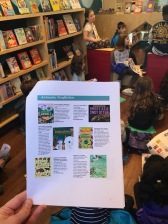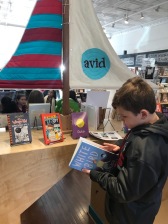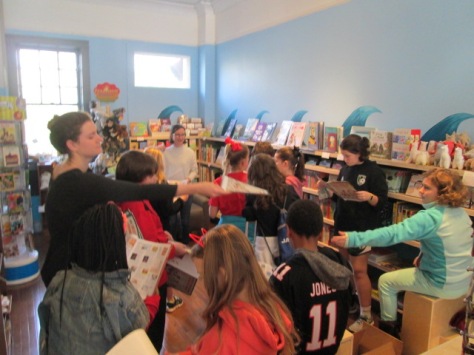
Now that winter break is over, our book budget students are back at work. This week we took 2 separate trips to our local independent bookstore, Avid Bookshop. I had almost 40 kids split across the 2 days. Avid Bookshop is located within 1 mile of our school so we can easily take a walking field trip to the store, and most of our students already have a permission slip on file.

The purpose of this trip was to continue to create a consideration list of books that met our purchasing goals. We already did this with Jim Boon from Capstone Publishers before the break. When we arrived at Avid, we met with Hannah DeCamp, who manages the Children’s Department. Students sat on the book boat and in the floor while Hannah book talked several recent books that fit our goals. She even made a personalized book budget handout with books broken down into our goal categories. Wow!
Next, Hannah gave students an overview of the different sections that they might browse for this project: board books, picture books, early readers, juvenile nonfiction, kids graphic novels, and middle grade. Since Avid Bookshop serves all readers, we had to remind students that some books might fit our goals but not elementary-age readers.
Next, students browsed the store. As they discovered books that fit our goals or books that were of high interest to Barrow readers, they came to my computer where we scanned the ISBN into a spreadsheet and typed the title/price of the book. Again, students didn’t worry about cost at this point. They simply captured all the titles we were interested in.
We also reminded students that Avid can order pretty much any book we would want so students added some books to our list that were requested by students and we couldn’t get from Capstone Publishers.
Some students also brought money to shop so for the last step students made their purchases. Hannah gave all students an Avid bookmark and she sent us away with several Advance Reader Copies to browse back at school.
Before we returned to school, we met together outside and debriefed our experience. One of the things that I shared with students is how important Avid Bookshop is in our community. I reminded students about all of the authors & illustrators who visit our school. Each time those authors/illustrators visit, it is because of Avid Bookshop and every book that students purchase for those visits comes right from this store. We talked about how Avid gives us a small discount as a school, but they give us so much more because they are part of our community and support our school and community by bringing authors and illustrators for us to learn from.

Back at school, students took time to review the Advance Reader Copies of books and we added a few more books to our list.
Next Steps
We’ve reached a very hard part of our project. Next week, students will meet to comb through our lists and make difficult decisions about what we purchase and what we cut from our lists. I can’t wait to hear their conversations and see their decisions.





















































































































































































